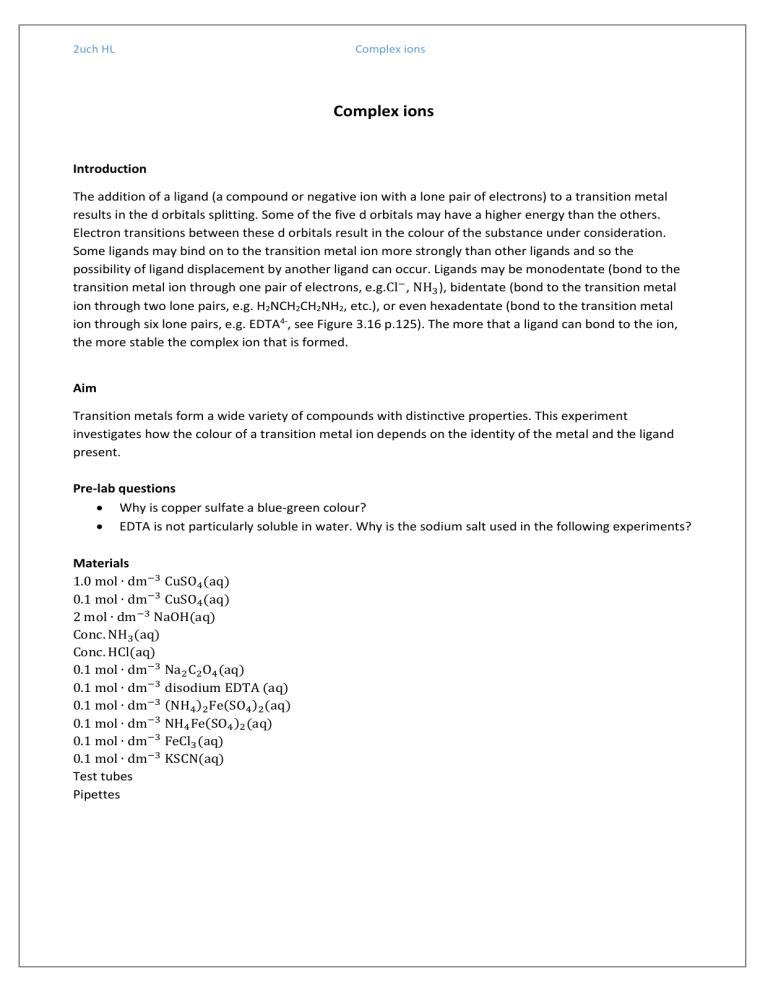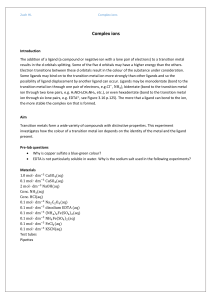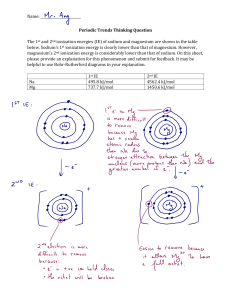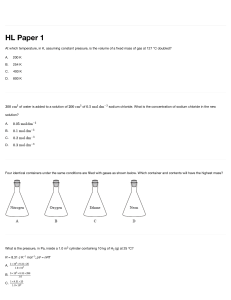
2uch HL Complex ions Complex ions Introduction The addition of a ligand (a compound or negative ion with a lone pair of electrons) to a transition metal results in the d orbitals splitting. Some of the five d orbitals may have a higher energy than the others. Electron transitions between these d orbitals result in the colour of the substance under consideration. Some ligands may bind on to the transition metal ion more strongly than other ligands and so the possibility of ligand displacement by another ligand can occur. Ligands may be monodentate (bond to the transition metal ion through one pair of electrons, e.g.Cl− , NH3 ), bidentate (bond to the transition metal ion through two lone pairs, e.g. H2NCH2CH2NH2, etc.), or even hexadentate (bond to the transition metal ion through six lone pairs, e.g. EDTA4-, see Figure 3.16 p.125). The more that a ligand can bond to the ion, the more stable the complex ion that is formed. Aim Transition metals form a wide variety of compounds with distinctive properties. This experiment investigates how the colour of a transition metal ion depends on the identity of the metal and the ligand present. Pre-lab questions Why is copper sulfate a blue-green colour? EDTA is not particularly soluble in water. Why is the sodium salt used in the following experiments? Materials 1.0 mol ∙ dm−3 CuSO4 (aq) 0.1 mol ∙ dm−3 CuSO4 (aq) 2 mol ∙ dm−3 NaOH(aq) Conc. NH3 (aq) Conc. HCl(aq) 0.1 mol ∙ dm−3 Na2 C2 O4 (aq) 0.1 mol ∙ dm−3 disodium EDTA (aq) 0.1 mol ∙ dm−3 (NH4 )2 Fe(SO4 )2 (aq) 0.1 mol ∙ dm−3 NH4 Fe(SO4 )2 (aq) 0.1 mol ∙ dm−3 FeCl3 (aq) 0.1 mol ∙ dm−3 KSCN(aq) Test tubes Pipettes 2uch HL Complex ions Method Read these instructions fully then draw up a suitable table into which you can put the results. You should record any changes you observe. Part 1, adding sodium hydroxide Put 2 cm3 of 1.0 mol ∙ dm−3copper(II) sulfate solution into a test tube and add drops of sodium hydroxide solution. Put 2 cm3 of ammonium iron(II) sulfate into a test tube into a test tube and add drops of sodium hydroxide solution. Put 2 cm3 of ammonium iron(III) sulfate into a test tube and add drops of sodium hydroxide solution. o What happens to the colour of the solutions when they are left over a number of days? o Suggest an explanation for any changes you observe. Part 2, changing ligands with Cu2+ Working in a fume cupboard, carefully add concentrated ammonia solution to 2 cm3 of copper(II) sulfate solution in a test tube with shaking, until there is no more visible change. o Explain the role of the ammonia in these changes. Now add concentrated hydrochloric acid slowly and carefully to same test tube. o There are two separate reactions to observe. Suggest an explanation for the two distinct reactions. Put 2 cm3 of 1.0 mol ∙ dm−3copper(II) sulfate solution into a test tube, and slowly add sodium ethanedioate solution until there is no further colour change. o Explain the role of the sodium ethanedioate in any change. Put 2 cm3 of 0.1 mol ∙ dm−3copper(II) sulfate solution into a test tube, and slowly add the solution of the disodium salt of EDTA to the test tube until there is no further colour change. o Explain the role of the disodium salt of EDTA in any change. Part 3, changing ligands with Fe3+ Put 2 cm3 of iron(III) chloride solution into a test tube, and slowly add potassium thiocyanate solution until there is no further colour change. o Explain the role of the potassium thiocyanate. Analysis For each experiment, write down the formula of the complex ion or salt that is formed. You may need to use textbooks or the internet in order to do this. Try and write an equation for each of the reactions. Remember that all of the ligands present must be in the equation. Classify the experiments as ligand displacement and/or precipitation reactions. Evaluation and conclusion Using the equations, try and suggest what is happening in each of these reactions. Which of the ligands are capable of displacing others from solution? Can you put the ligands in an order of increasing ability to displace each other from solution?




